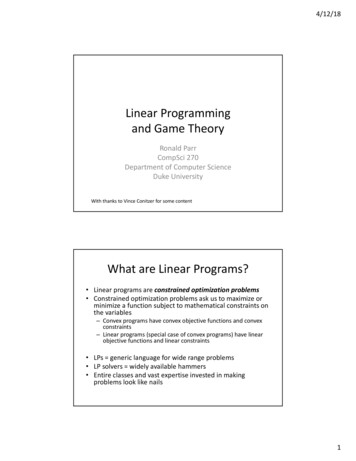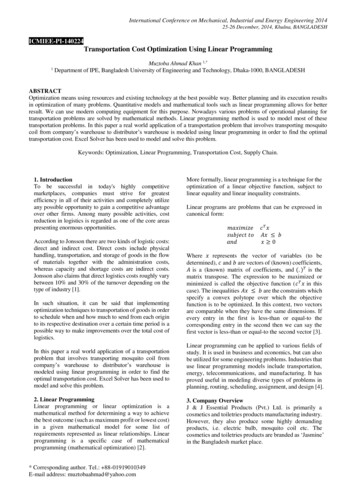
Transcription
4/12/18Linear Programmingand Game TheoryRonald ParrCompSci 270Department of Computer ScienceDuke UniversityWith thanks to Vince Conitzer for some contentWhat are Linear Programs? Linear programs are constrained optimization problems Constrained optimization problems ask us to maximize orminimize a function subject to mathematical constraints onthe variables– Convex programs have convex objective functions and convexconstraints– Linear programs (special case of convex programs) have linearobjective functions and linear constraints LPs generic language for wide range problems LP solvers widely available hammers Entire classes and vast expertise invested in makingproblems look like nails1
4/12/18Real-World Applications Railroads – freight car allocation Agriculture – optimal mix of crops to plant Warfare – logistics, optimal mix of defensive assets,allocation of resources (LP techniques influenced byWWII problems) Networking – capacity management Microchips – Optimization of component placementPhoto: Public Domain, https://commons.wikimedia.org/w/index.php?curid 17040973Linear programs: example Make reproductions of 2 paintings Painting 1: Sells for 30 Requires 4 units of blue, 1 green, 1 redPainting 2 Sells for 20Requires 2 blue, 2 green, 1 redmaximize 3x 2ysubject to4x 2y 16x 2y 8x y 5x 0y 0We have 16 units blue, 8 green, 5 red2
4/12/18Solving the linear program graphicallymaximize 3x 2ysubject to4x 2y 16x 2y 8x y 5x 0y 0864optimal solution:x 3, y 2202468Feasible region region not violating constraintsLinear Programs in General Linear constraints, linear objective function– Maximize (minimize): !!f (x)– Subject to: Linear function of vector x!!Ax bMatrix A Can swap maximize/minimize, / ; can add equality View as search: Searches space of values of x Alternatively: Search for tight constraints w/highobjective function value3
4/12/18Linear Programs (max formulation)maximize : c T xsubject to : Ax b:x³0 Note: min formulation also possible– Min: cTx– Subject to: Ax b Some use equality as the canonical representation(introducing slack variables) LP tricks– Multiply by -1 to reverse inequalities– Can easily introduce equality constraintsExample: MDP Solved as an LPV(s) max a R(s,a) γ P(s' s,a)V(s')s'Issue: Turn the non-linear max into a collection of linear constraints s,a :V (s) R(s,a) γ s' P(s' s,a)V(s')!!MINIMIZE: V(s)!! sOptimal action hastight constraints 4
4/12/18Duality For every LP there is an equivalent “Dual” problem Solution to primal can be used to reconstructsolution to dual, and vice versa LP duality:minimize : c T xsubject to : Ax bmaximize : bT ysubject to : A T y c:x³0:y ³0Solving linear programs (1) Optimal solutions always exist at vertices of thefeasible region– Why?– Assume you are not at a vertex, you can always push furtherin direction that improves objective function (or at leastdoesn’t hurt)– How many vertices does a kxn matrix imply? Dumb(est) algorithm:– Given n variables, k constraints– Check all k-choose-n O(kn) possible vertices5
4/12/18Solving linear programs (2) Smarter algorithm (simplex)– Pick a vertex– Repeatedly hop to neighboring (one different tightconstrain) vertices that improve the objective function– Guaranteed to find solution (no local optima)– May take exponential time in worst case (though rarely) Still smarter algorithm– Move inside the interior of the feasible region, in directionthat increases objective function– Stop when no further improvements possible– Tricky to get the details right, but weakly polynomial timeWhat Happens In Higher Dimensions (1)Understanding the Feasible Region864Intuition: Objective function defines “down” Feasible region is a “bowl” Want to find lowest point on the rotated bowl2024686
4/12/18What Happens In Higher Dimensions (2)lines- hyperplanes Inequality w/2 variables - one side of a line3 variables - one side of a planek variables - one side of hyperplanePhysical /Orrefors-x22Zenithx22-Pattern-Crystal-BowlSolving LPs in Practice Use commercial products like cplex or gurobi(there is even an Excel plug-in) Don’t implement LP solver yourself! Do not use Matlab’s linprog for anything otherthan small problems. Really. No – REALLY!Photo taken by Liane Moeller - Chris Barnes, Public Domain, https://commons.wikimedia.org/w/index.php?curid 90169567
4/12/18Modified LPmaximize 3x 2ysubject to4x 2y 15x 2y 8x y 5x 0y 0Optimal solution: x 2.5, y 2.5Solution value 7.5 5 12.5Half paintings?Integer (linear) programmaximize 3x 2y8subject to4x 2y 15 6x 2y 8x y 54x 0, integery 0, integer 20optimal IPsolution: x 2, y 3(objective 12)optimal LPsolution: x 2.5,y 2.5(objective 12.5)24688
4/12/18Mixed integer (linear) programmaximize 3x 2ysubject to4x 2y 15x 2y 8x y 5x 0y 0, integer86optimal IPsolution: x 2, y 3(objective 12)optimal LPsolution: x 2.5,y 2.5(objective 12.5)4optimal MIPsolution: x 2.75,y 2(objective 12.25)202468Solving (M)IPs (Mixed) Integer programs are NP-hard to solve Intuition: Constraint surface is jagged; no obviousway to avoid checking exponential number ofassignments to integer variables In practice:– Constraints often give clues on how to restrict numberof solutions considered– Smart solvers (cplex, gurobi) can sometimes findsolutions to large (M)IPs surprisingly quickly (andsurprisingly slowly)9
4/12/18Linear Programming Summary LPs are a language that can express a widerange of optimization problems that can besolved fairly efficiently Skill/art/science of modeling problems as LPs Nonlinear or integer versions also possible –usually lead to more accurate modeling of realworld problem, but potentially much moreexpensive to solveWhat is Game Theory? I Very general mathematical framework to study situationswhere multiple agents interact, including:– Popular notions of games– Everything up to and including multistep, multiagent,simultaneous move, partial information games– Example Duke CS research: Aiming sensors to catch hidingenemies, assigning guards to posts– Can even include negotiating, posturing and uncertainty aboutthe players and game itself von Neumann and Morgenstern (1944) was a majorlaunching point for modern game theory Nash: Existence of equilibria in general sum games(wikipedia)10
4/12/18What is game theory? II Study of settings where multiple agents each have– Different preferences (utility functions),– Different actions Each agent’s utility (potentially) depends on all agents’ actions– What is optimal for one agent depends on what other agents do– Can be circular Game theory studies how agents can rationally form beliefs overwhat other agents will do, and (hence) how agents should act Useful for acting and (potentially) predicting behavior of others Not necessarily descriptiveReal World Game Theory Examples WarAuctionsAnimal behaviorNetworking protocolsPeer to peer networking behaviorRoad traffic Mechanism design:– Suppose we want people to do X?– How to engineer situation so they will act that way?11
4/12/18Rock, Paper, Scissors Zero Sum Formulation In zero sum games, one player’s loss is other’s gain Payoff matrix:RPR01PS 1 10 10!!S 1 1 Minimax solution maximizes worst case outcome Rock, Paper, Scissors Equations R,P,S probability that we play rock, paper, orscissors respectively (R P S 1) U is our expected utility Bounding our utility:– Opponent rock case: U P – S– Opponent paper case: U S – R– Opponent scissors case: U R – P Want to maximize U subject to constraints Solution: (1/3, 1/3, 1/3)12
4/12/18Rock, Paper, Scissors LP Formulation Our variables are: x [U,R,P,S]T We want:– Maximize U–U P–S–U S–R–U R–P– R P S 1maximize : c T x How do we make this fit: subject to : Ax b:x³0?Rock Paper Scissors LP Formulationx [U,R,P,S]T 1 0 1 1 1 1 0 1 A 1 1 1 0 0 1 1 1 0 1 1 1 Tb [0,0,0,1, 1]maximize : c T xsubject to : Ax b:x³0c [1,0,0,0]TFirst row of Ax: U – P S 013
4/12/18Rock, Paper, Scissors Solution If we feed this LP to an LP solver we get:– R P S 1/3– U 0 Solution for the other player is:– The same – By symmetry This is the minimax solution This is also an equilibrium– No player has an incentive to deviate– (Defined more precisely later)Tangent: Why is RPS Fun? OK, it’s not Why might RPS be fun?– Try to exploit non-randomness in your friends– Try to be random yourself14
4/12/18Generalizing We can solve any two player, simultaneous move,zero sum game with an LP– One variable for each of player 1’s actions– Variables must be a probability distribution(constraints)– One constraint for each of player 2’s actions (Player 1’sutility must be less than or equal to outcome for eachplayer 2 action.)– Maximize player 1’s utility Can solve resulting LP using an LP solver in timethat is polynomial in total number of actionsMinimax Solutions in General What do we know about minimax solutions?– Can a suboptimal opponent trick minimax?– When should we abandon minimax? Minimax solutions for 2-player zero-sum games can always befound by solving a linear program The minimax solutions will also be equilibria (more on that later) For general sum games:– Minimax does not apply– Solutions (equilibria) may not be unique– Need to search for equilibria using more computationally intensivemethods15
4/12/18General Sum Games“Chicken” Two players drive cars towards each other If one player goes straight, that player wins If both go straight, they both dieSDDSDDSource: wikipediaSS0, 0 -1, 11, -1 -5, -5not zero-sum16
4/12/18Reasoning About General Sum Games Can’t approach as an optimization problem Minimax doesn’t apply– Other players’ objectives might be aligned w/ yours– Might be partially aligned Need a solution concept where each players is“satisfied” WRT his/her objectivesRock-paper-scissors – Seinfeld variantMICKEY: All right, rock beats paper!(Mickey smacks Kramer's hand for losing)KRAMER: I thought paper covered rock.MICKEY: Nah, rock flies right through paper.KRAMER: What beats rock?MICKEY: (looks at hand) Nothing beats rock.0, 0 1, -1 1, -1Note: still zero-sum,but useful for understandinga different way of thinkingabout game solutions.-1, 1 0, 0 -1, 1-1, 1 1, -1 0, 017
4/12/18Dominance Player i’s strategy si strictly dominates si’ if– for any s-i, ui(si , s-i) ui(si’, s-i) si weakly dominates si’ if– for any s-i, ui(si , s-i) ui(si’, s-i); and– for some s-i, ui(si , s-i) ui(si’, s-i)-i “the player(s) otherthan i”0, 0 1, -1 1, -1strict dominance-1, 1 0, 0 -1, 1weak dominance-1, 1 1, -1 0, 0Prisoner’s Dilemma Pair of criminals has been caught District attorney has evidence to convict them of a minorcrime (1 year in jail); knows that they committed a majorcrime together (3 years in jail) but cannot prove it Offers them a deal:– If both confess to the major crime, they each get a 1 year reduction– If only one confesses, that one gets 3 years reductionconfessconfessdon’t confessdon’t confess-2, -2 0, -3-3, 0 -1, -118
4/12/18“Should I buy an SUV?”accident costpurchasing gas costcost: 5cost: 3cost: 5cost: 5cost: 8cost: 2cost: 5cost: 5-10, -10-7, -11-11, -7-8, -8Iterated dominance Iterated dominance: remove (strictly/weakly)dominated strategy, repeat Iterated strict dominance on Seinfeld’s RPS:0, 0 1, -1 1, -1-1, 1 0, 0 -1, 1-1, 1 1, -1 0, 00, 0 1, -1-1, 1 0, 019
4/12/18Mixed strategies Mixed strategy for player i probability distributionover player i’s (pure) strategies E.g. 1/3, 1/3, 1/3 Example of dominance by a mixed strategy:1/23, 0 0, 01/20, 0 3, 01, 0 1, 0Best Responses Let A be a matrix of player 1’s payoffs Let s2 be a mixed strategy for player 2 As2 vector of expected payoffs for each strategy forplayer 1 Highest entry indicates best response for player 1 Any mixture of ties is also BR, but can only tie a pure BR Generalizes to 2 players0, 0 -1, 11, -1 -5, -5s220
4/12/18Nash equilibrium [Nash 50] A vector of strategies (one for each player) a strategy profile Strategy profile (σ1, σ2 , , σn) is a Nash equilibrium if each σi is abest response to σ-i– That is, for any i, for any σi’, ui(σi, σ-i) ui(σi’, σ-i) Does not say anything about multiple agents changing theirstrategies at the same time In any (finite) game, at least one Nash equilibrium (possibly usingmixed strategies) exists [Nash 50] (Note - singular: equilibrium, plural: equilibria)Equilibrium Strategiesvs.Best Responses equilibrium strategy - best response? best response - equilibrium strategy? Consider Rock-Paper-Scissors– Is (1/3, 1/3, 1/3) a best response to (1/3, 1/3, 1/3)?– Is (1, 0, 0) a best response to (1/3, 1/3, 1/3)?– Is (1, 0, 0) a strategy for any equilibrium?0, 0-1, 11, -11, -10, 0-1, 1-1, 11, -10, 021
4/12/18Nash equilibria of “chicken”DSSDDSDS0, 0 -1, 11, -1 -5, -5 (D, S) and (S, D) are Nash equilibria– They are pure-strategy Nash equilibria: nobody randomizes– They are also strict Nash equilibria: changing your strategy will make youstrictly worse off No other pure-strategy Nash equilibriaEquilibrium SelectionDS SDDSDS0, 0 -1, 11, -1 -5, -5(D, S) and (S, D) are Nash equilibriaWhich do you play?What if player 1 assumes (S, D), player 2 assumes (D, S)Play is (S, S) (-5, -5)!!! This is the equilibrium selection problem22
4/12/18Rock-paper-scissors0, 0 -1, 1 1, -11, -1 0, 0 -1, 1-1, 1 1, -1 0, 0 Any pure-strategy Nash equilibria? It has a mixed-strategy Nash equilibrium:Both players put probability 1/3 on each actionNash equilibria of “chicken” DSDS0, 0 -1, 11, -1 -5, -5 Is there a Nash equilibrium that uses mixed strategies -- say, where player 1 uses amixed strategy? If a mixed strategy is a best response, then all of the pure strategies that itrandomizes over must also be best responses So we need to make player 1 indifferent between D and S-pcS probability Player 1’s utility for playing D -pcSthat columnplayer plays s Player 1’s utility for playing S pcD - 5pcS 1 - 6pcSccc So we need -p S 1 - 6p S which means p S 1/5 Then, player 2 needs to be indifferent as well Mixed-strategy Nash equilibrium: ((4/5 D, 1/5 S), (4/5 D, 1/5 S))– People may die! Expected utility -1/5 for each player23
4/12/18Computational Issues Zero-sum games - solved efficiently as LP General sum games may require exponentialtime (in # of actions) to find a singleequilibrium (no known efficient algorithm and goodreasons to suspect that none exists) Some better news: Despite bad worst-casecomplexity, many games can be solved quicklyGame Theory Issues How descriptive is game theory?– Some evidence that people play equilibria– Also, some evidence that people act irrationally– If it is computationally intractable to solve for equilibria oflarge games, seems unlikely that people are doing this How reasonable is (basic) game theory?– Are payoffs known?– Are situations really simultaneous move with noinformation about how the other player will act?– Are situations really single-shot? (repeated games)– How is equilibrium selection handled in practice?24
4/12/18Extensions Partial information Uncertainty about the game parameters, e.g., payoffs(Bayesian games) Repeated games: Simple learning algorithms can converge toequilibria in some repeated games Multistep games with distributions over next states (game theory MDPs stochastic games) Multistep partial information (Partially observable stochastic games) Game theory is so general, that it can encompass essentially allaspects of strategic, multiagent behavior, e.g., negotiating, threats,bluffs, coalitions, bribes, etc.Conclusions Game theory tells us how to act in strategic situations –different agents with different goals acting withawareness of other agents Zero sum case is relatively easy General sum case is computationally hard – some niceresults for special cases Extensions address some shortcomings/assumptions ofbasic model but at additional computational cost25
Linear Programming and Game Theory Ronald Parr CompSci270 Department of Computer Science Duke University With thanks to Vince Conitzerfor some content What are Linear Programs? Linear programs are constrained optimization problems Constrained optimization problems ask us to ma










